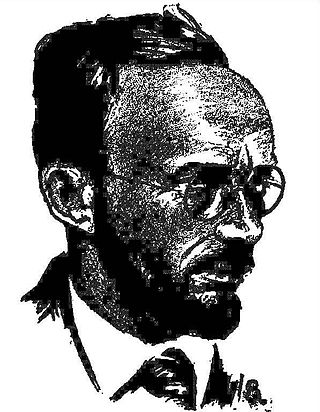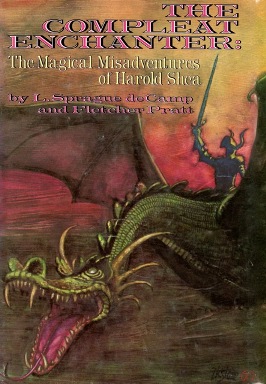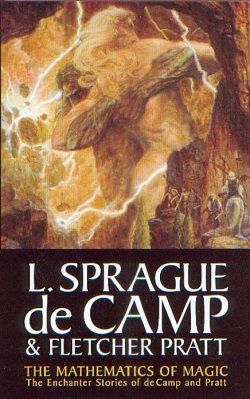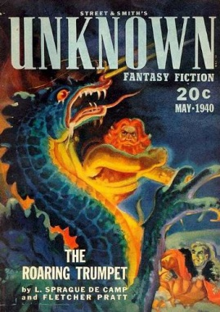
Lyon Sprague de Camp was an American author of science fiction, fantasy and non-fiction literature. In a career spanning 60 years, he wrote over 100 books, including novels and works of non-fiction, including biographies of other fantasy authors. He was a major figure in science fiction in the 1930s and 1940s.

Murray Fletcher Pratt was an American writer of history, science fiction, and fantasy. He is best known for his works on naval history and the American Civil War and for fiction written with L. Sprague de Camp.

The Castle of Iron is the title of a fantasy novella by American authors L. Sprague de Camp and Fletcher Pratt, and of the novel into which it was later expanded by the same authors. It was the third story in their Harold Shea series. As a 35,000-word novella it was first published in the fantasy magazine Unknown for April, 1941. The revised and expanded novel version was first published in hardcover by Gnome Press in 1950, and in paperback by Pyramid Books in 1962. The book has been reprinted by a number of other publishers since its first appearance. An e-book edition was published by Gollancz's SF Gateway imprint on September 29, 2011 as part of a general release of de Camp's works in electronic form. The novel has been combined with other books in the series in the omnibus editions The Compleat Enchanter (1975), The Complete Compleat Enchanter (1989) and The Mathematics of Magic: The Enchanter Stories of L. Sprague de Camp and Fletcher Pratt (2007). It has also been translated into Italian.

Wall of Serpents is a collection of two fantasy short stories by American science fiction and fantasy authors L. Sprague de Camp and Fletcher Pratt, the third volume in their Harold Shea series. The pieces were originally published in the magazines Fantasy Fiction and Beyond Fantasy Fiction in the issues for June 1953 and October 1954. The collection was first published in hardcover by Avalon Books in 1960, with a new edition from Phantasia Press in 1978. The first paperback edition was published by Dell Books in 1979. A 1980 edition published by Sphere Books was retitled The Enchanter Compleated. An E-book edition was published by Gollancz's SF Gateway imprint on September 29, 2011 as part of a general release of de Camp's works in electronic form.

The Enchanter Completed: A Tribute Anthology for L. Sprague de Camp is a 2005 gedenkschrift honoring American science fiction and fantasy author L. Sprague de Camp, in the form of an anthology of short stories edited by Harry Turtledove. It was first published in paperback by Baen Books. All but one of the pieces are original to the anthology; the remaining one, Frederik Pohl's "The Deadly Mission of P. Snodgrass", was originally published in 1964 in the magazine Galaxy.

The Enchanter Reborn is an anthology of five fantasy short stories edited by American writers L. Sprague de Camp and Christopher Stasheff, the first volume in their continuation of the Harold Shea series by de Camp and Fletcher Pratt. It was first published in paperback by Baen Books in 1992; an ebook edition followed from the same publisher in May 2013. The book has also been translated into Italian. All but one of the pieces are original to the anthology; the exception, de Camp's "Sir Harold and the Gnome King", first appeared in the World Fantasy Convention program book in 1990 and was then published as a separate chapbook in 1991.

The Exotic Enchanter is an anthology of four fantasy short stories edited by American writers L. Sprague de Camp and Christopher Stasheff. The Exotic Enchanter is the second volume in the continuation of the Harold Shea series by de Camp and Fletcher Pratt. It was first published in paperback by Baen Books in 1995; an ebook edition followed from the same publisher in September 2013. All the pieces are original to the anthology.

The Compleat Enchanter: The Magical Misadventures of Harold Shea is an omnibus collection of three fantasy stories by American writers L. Sprague de Camp and Fletcher Pratt, gathering material previously published in two volumes as The Incomplete Enchanter (1941) and The Castle of Iron (1950), the first two books in their Harold Shea series, with the essay "Fletcher and I", de Camp's paean to his deceased collaborator. The collection was first published in hardcover by Nelson Doubleday in 1975 as an offering for its Science Fiction Book Club, and was reissued in paperback by Del Rey Books in 1976. Minus the essay, it has more recently been combined with Wall of Serpents (1960), the third book of the series in the omnibus edition The Complete Compleat Enchanter (1989). This book had been left out of The Compleat Enchanter due to "considerations of space and …contractual considerations". The stories in the collection were originally published in the magazine Unknown in the issues for May and August 1940 and April 1941.

The Complete Compleat Enchanter is an omnibus collection of five fantasy stories by American authors L. Sprague de Camp and Fletcher Pratt, gathering material previously published in three volumes as The Incomplete Enchanter (1941), The Castle of Iron (1950), and Wall of Serpents (1960), and represents an expansion of the earlier omnibus The Compleat Enchanter, which contained only the material in the first two volumes. The expanded version also differs from the previous omnibus by omitting its afterword, de Camp's essay "Fletcher and I". The omnibus is the first edition of the authors' Harold Shea series to be complete in one volume. It has appeared under three different titles. It was first published in the UK in paperback by Sphere Books in 1988 under the title The Intrepid Enchanter and with a foreword by Catherine Crook de Camp. The first US edition appeared under the title The Complete Compleat Enchanter, and replaces the foreword with a preface by David Drake. That edition was published by Baen Books in 1989, and has been reprinted a number of times since. Orion Books published an edition in the UK under the title The Compleat Enchanter in 2000 as volume 10 of their Fantasy Masterworks series. The stories in the collection were originally published in magazine form in the May 1940, August 1940 and April 1941 issues of Unknown, the June 1953 issue of Beyond Fantasy, and the October 1954 issue of Fantasy.

The Mathematics of Magic: The Enchanter Stories of L. Sprague de Camp and Fletcher Pratt is an omnibus collection of seven fantasy stories by American science fiction and fantasy authors L. Sprague de Camp and Fletcher Pratt, gathering material previously published in three volumes as The Incomplete Enchanter (1941), The Castle of Iron (1950), and Wall of Serpents (1960) together with additional material from The Enchanter Reborn (1992) and The Exotic Enchanter (1995). It represents an expansion of the earlier omnibuses The Compleat Enchanter, which contained only the material in the first two volumes, and The Complete Compleat Enchanter, which contained only the material in the first three volumes. The expanded version also differs from the previous omnibuses in its selection of supplementary material. The Mathematics of Magic is the first edition of the authors' Harold Shea series to include every one of their contributions to it in one volume. Contributions to the series of other authors from the collections of the 1990s are omitted.
Bibliography of science fiction, fantasy, historical fiction and nonfiction writer L. Sprague de Camp:

Sir Harold and the Gnome King is a fantasy novella American writer L. Sprague de Camp, part of the Harold Shea series he originated in collaboration with Fletcher Pratt and later continued with Christopher Stasheff. It was first published in the 1990 World Fantasy Convention Program Book. It first appeared in book form as a limited edition hardcover chapbook issued by Wildside Press in August, 1991, with a paperback edition following from the same publisher in October of the same year. In addition to the title story, the book includes an afterword by de Camp and illustrations by Stephen Fabian; the paperback edition also has a cover by Fabian. The story was afterwards reprinted, slightly revised, in de Camp and Stasheff's shared world anthology The Enchanter Reborn (1992). The original version was later reprinted together with the remainder of the de Camp/Pratt Harold Shea stories in the collection The Mathematics of Magic: The Enchanter Stories of L. Sprague de Camp and Fletcher Pratt (2007).

Sir Harold of Zodanga is a fantasy novella by American writer L. Sprague de Camp, part of the Harold Shea series he originated in collaboration with Fletcher Pratt and later continued with Christopher Stasheff. It was first published in paperback by Baen Books in de Camp and Stasheff's shared world anthology The Exotic Enchanter (1995). It was later reprinted together with the remainder of the de Camp/Pratt Harold Shea stories in the collection The Mathematics of Magic: The Enchanter Stories of L. Sprague de Camp and Fletcher Pratt (2007).

"The Roaring Trumpet" is a fantasy novella by American writers L. Sprague de Camp and Fletcher Pratt. The initial story in their Harold Shea series, it was first published in the May 1940 issue of the fantasy pulp magazine Unknown. It first appeared in book form, together with its sequel, "The Mathematics of Magic", in the collection The Incomplete Enchanter, issued in hardcover by Henry Holt and Company in 1941, and in paperback by Pyramid Books in 1960. It has since been reprinted in various collections by numerous other publishers, including The Compleat Enchanter (1975), The Incompleat Enchanter (1979), The Complete Compleat Enchanter (1989), and The Mathematics of Magic: The Enchanter Stories of L. Sprague de Camp and Fletcher Pratt (2007). It has been translated into Dutch and Italian. In 2016, the story was shortlisted for the Retro Hugo Award for Best Novella.

"The Mathematics of Magic" is a fantasy novella by American writers L. Sprague de Camp and Fletcher Pratt, the second story in their Harold Shea series. It was first published in the August 1940 issue of the fantasy pulp magazine Unknown. It first appeared in book form, together with the preceding novella, "The Roaring Trumpet", in the collection The Incomplete Enchanter, issued in hardcover by Henry Holt and Company in 1941, and in paperback by Pyramid Books in 1960. It has since been reprinted in various collections by numerous other publishers, including The Compleat Enchanter (1975), The Incompleat Enchanter (1979), The Complete Compleat Enchanter (1989), and The Mathematics of Magic: The Enchanter Stories of L. Sprague de Camp and Fletcher Pratt (2007). It has been translated into Dutch and Italian. In 2016, the story was shortlisted for the Retro Hugo Award for Best Novella.

The Incomplete Enchanter is a collection of two fantasy novellas by American writers L. Sprague de Camp and Fletcher Pratt, the first volume in their Harold Shea series. The pieces were originally published in the magazine Unknown in the issues for May and August 1940. The collection was first published in hardcover by Henry Holt and Company in 1941 and in paperback by Pyramid Books in 1960.

Ras Thavas is a fictional character created by Edgar Rice Burroughs in his 1927 novel The Master Mind of Mars. Within the narrative framework of the story he is an elderly Martian mad scientist of the city-state of Toonol, the "Master Mind" of the novel's title, skilled in the surgical transplantation of brains. He takes in protagonist Ulysses Paxton, an earthman newly arrived on the planet, and educates him in the ways of Barsoom, as Mars is known to its inhabitants.

The Wall of Serpents is a fantasy novella by American science fiction and fantasy authors L. Sprague de Camp and Fletcher Pratt. The fourth story in their Harold Shea series, it was first published in the June 1953 issue of the fantasy pulp magazine Fantasy Fiction. It first appeared in book form, together with its sequel, "The Green Magician", in the collection Wall of Serpents, issued in hardcover by Avalon Books in 1960; the book has been reissued by a number of other publishers since. It has also been reprinted in various anthologies and collections, including Great Short Novels of Adult Fantasy I (1972), The Complete Compleat Enchanter (1989), and The Mathematics of Magic: The Enchanter Stories of L. Sprague de Camp and Fletcher Pratt (2007). It has been translated into Italian and German.

The Green Magician is a fantasy novella by American writers L. Sprague de Camp and Fletcher Pratt. The fifth story in their Harold Shea series, it was first published in the November 1954 issue of the fantasy pulp magazine Beyond Fiction. It first appeared in book form, together with "The Wall of Serpents", in the collection Wall of Serpents, issued in hardcover by Avalon Books in 1960; the book has been reissued by a number of other publishers since. It has also been reprinted in various magazines, anthologies and collections, including The Dragon, The Complete Compleat Enchanter (1989), Masterpieces of Fantasy and Enchantment (1988), and The Mathematics of Magic: The Enchanter Stories of L. Sprague de Camp and Fletcher Pratt (2007). It has been translated into Italian and German.

















